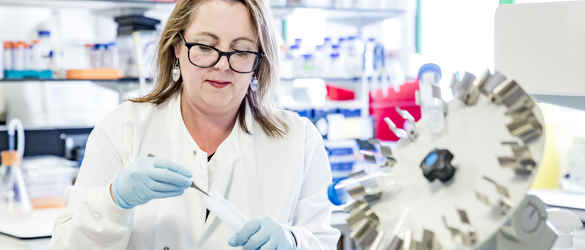Cone dystrophy
The light-sensing cells in the retina come in two main kinds: rods and cones. Rods are extremely sensitive and work better in dim light, whereas cones are more effective in bright light. Cones give us our colour vision and although they exist across the retina, they are densely clustered around the macula.
Cone dystrophy stops the cones working, leading to loss of central and colour vision. People with stationary dystrophy have the same level of sight loss from birth or early childhood. Progressive dystrophy develops later and sight is lost gradually over time.
How is it inherited?
Cone dystrophy can be inherited in several ways, depending on which part of the gene has the mutation or mistake. Some are inherited dominantly, so appear in anyone who has one copy of the gene. Others are recessive, meaning that people may carry the faulty gene without developing any symptoms.
In some ‘X-linked’ versions, the mutation occurs on the X sex chromosome. Girls have two X chromosomes so the faulty gene on one will usually be corrected by the other, leading to mild symptoms, or none at all. Boys have only one X chromosome so if they carry the mutation, they will have symptoms.
In some people, the mutation occurs sporadically – that is, it appears for the first time in their genes and was not inherited from a parent.
What are the symptoms?
Symptoms vary widely. Even people who have the same dystrophy may notice symptoms at a different age, and see them progress at a different rate.
The main symptoms are photophobia (discomfort in bright light), loss of detailed vision, difficulty distinguishing colours and central sight loss. Symptoms are the same in both eyes but side vision is usually unaffected. Some people also develop rapid, uncontrolled eye movements (nystagmus) or find that their eyes ‘drift’ or wander.
The retinas of people with cone dystrophy may look relatively normal, even once they begin to lose their sight. The most useful test is an electroretinogram (ERG), which measures the retina’s response to flashes of light. The test is done twice, once in a well-lit room and again in the dark. If electrical activity is recorded in the dark but not in the light, it suggests that the cones are no longer working.
Treatment
We still do not clearly understand how cone dystrophies happen, or why people’s symptoms are so different. There is limited evidence that changes to your diet may slow sight loss caused by progressive cone dystrophies.
Research
Gene therapy has restored some sight to mice with cone dystrophy. More research is needed before we can say whether it could be used in humans too.
Explore our research projects
Since 1987 the Macular Society has invested around £10 million in over 100 research projects.
Looking for more information about living with an inherited macular dystrophy?
Call the Macular Society Helpline on 0300 3030 111 or email help@macularsociety.org
Last review date: 08 2021
Support for you
We provide free information and support to those with macular disease, along with their family and friends, to help people keep their independence.
Are you a young person or of working age?
The Macular Society supports everyone impacted by macular disease, including those with less common types of macular disease who may be younger or still working.
Free confidential advice and support
Call our helpline on 0300 3030 111
Lines are open 9am - 5pm Monday to Friday
About the Macular Society Helpline




